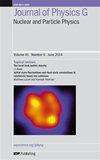关于特定 SUSY DFSZ 轴子模型中轴子/中微子混合暗物质的可能性
IF 3.5
3区 物理与天体物理
Q2 PHYSICS, NUCLEAR
Journal of Physics G: Nuclear and Particle Physics
Pub Date : 2024-04-17
DOI:10.1088/1361-6471/ad38cf
引用次数: 0
摘要
我们引入了四个超对称(SUSY)轴子模型,其中强CP问题和μ问题分别借助佩奇-奎因机制和金-尼尔斯机制得到了解决。轴子物理学通过引入轴子作为暗物质候选者丰富了SUSY模型,因此,最轻的超对称粒子(LSP)可能只是总暗物质的一部分。因此,轴子缓解了 SUSY 模型与大量实验测量之间的矛盾,如暗物质直接探测实验和μ介子反常磁矩的精确测量。在本文中,我们研究了最新的aμ测量和LUX-ZEPLIN(LZ)实验对希格斯诺类LSP遗迹密度的约束。此外,我们还考虑了轴子和轴信子宇宙学所产生的约束,并仔细研究了它们对我们模型参数空间的影响。对于构成暗物质剩余部分的轴子,我们发现传统的错位机制可以成功地解释普朗克卫星观测到的正确的暗物质遗迹密度。本文章由计算机程序翻译,如有差异,请以英文原文为准。
On the possibility of mixed axion/neutralino dark matter in specific SUSY DFSZ axion models
We introduce four supersymmetric (SUSY) axion models in which the strong CP problem and the μ problem are solved with the help of the Peccei–Quinn mechanism and the Kim-Nilles mechanism, respectively. The axion physics enriches the SUSY model by introducing axion as a dark matter candidate and, therefore, the lightest supersymmetric particle (LSP) could just be a part of the total dark matter. For this reason, axion relieves the tensions between SUSY models and numerous experimental measurements, such as the dark matter direct detection experiments and the precise measurements of anomalous magnetic moment of the muon a
μ
. In the present paper, we investigate the constraints imposed by the latest a
μ
measurements and LUX-ZEPLIN (LZ) experiment on the relic density of the Higgsino-like LSP. Additionally, we consider the constraints arising from the cosmology of saxions and axinos, and their impacts on the parameter space of our models are carefully examined. For the axion constituting the remaining portion of dark matter, we find that the conventional misalignment mechanism can successfully account for the correct dark matter relic density observed by the Planck satellite.
求助全文
通过发布文献求助,成功后即可免费获取论文全文。
去求助
来源期刊
CiteScore
7.60
自引率
5.70%
发文量
105
审稿时长
1 months
期刊介绍:
Journal of Physics G: Nuclear and Particle Physics (JPhysG) publishes articles on theoretical and experimental topics in all areas of nuclear and particle physics, including nuclear and particle astrophysics. The journal welcomes submissions from any interface area between these fields.
All aspects of fundamental nuclear physics research, including:
nuclear forces and few-body systems;
nuclear structure and nuclear reactions;
rare decays and fundamental symmetries;
hadronic physics, lattice QCD;
heavy-ion physics;
hot and dense matter, QCD phase diagram.
All aspects of elementary particle physics research, including:
high-energy particle physics;
neutrino physics;
phenomenology and theory;
beyond standard model physics;
electroweak interactions;
fundamental symmetries.
All aspects of nuclear and particle astrophysics including:
nuclear physics of stars and stellar explosions;
nucleosynthesis;
nuclear equation of state;
astrophysical neutrino physics;
cosmic rays;
dark matter.
JPhysG publishes a variety of article types for the community. As well as high-quality research papers, this includes our prestigious topical review series, focus issues, and the rapid publication of letters.

 求助内容:
求助内容: 应助结果提醒方式:
应助结果提醒方式:


